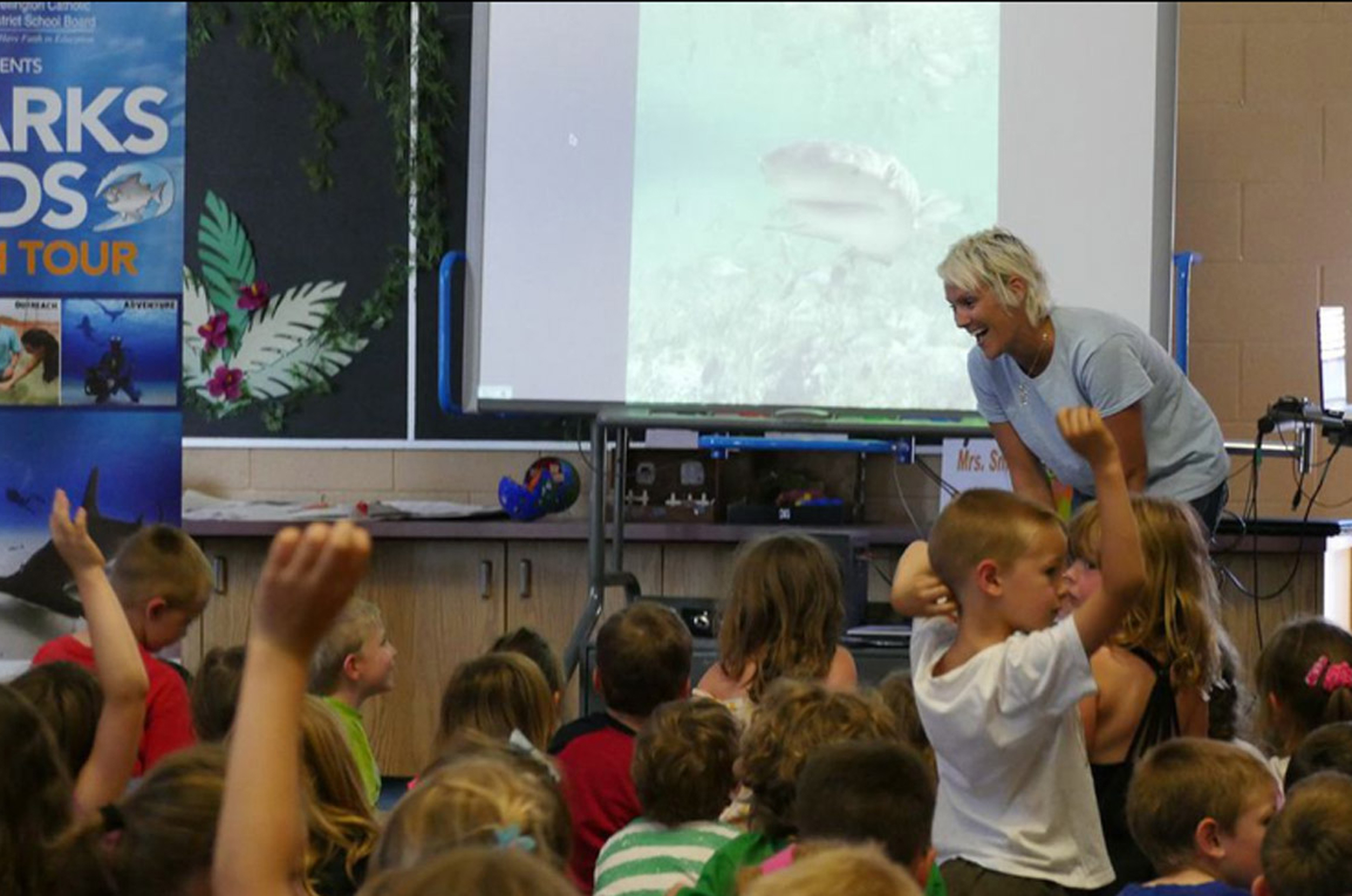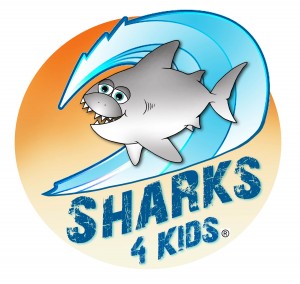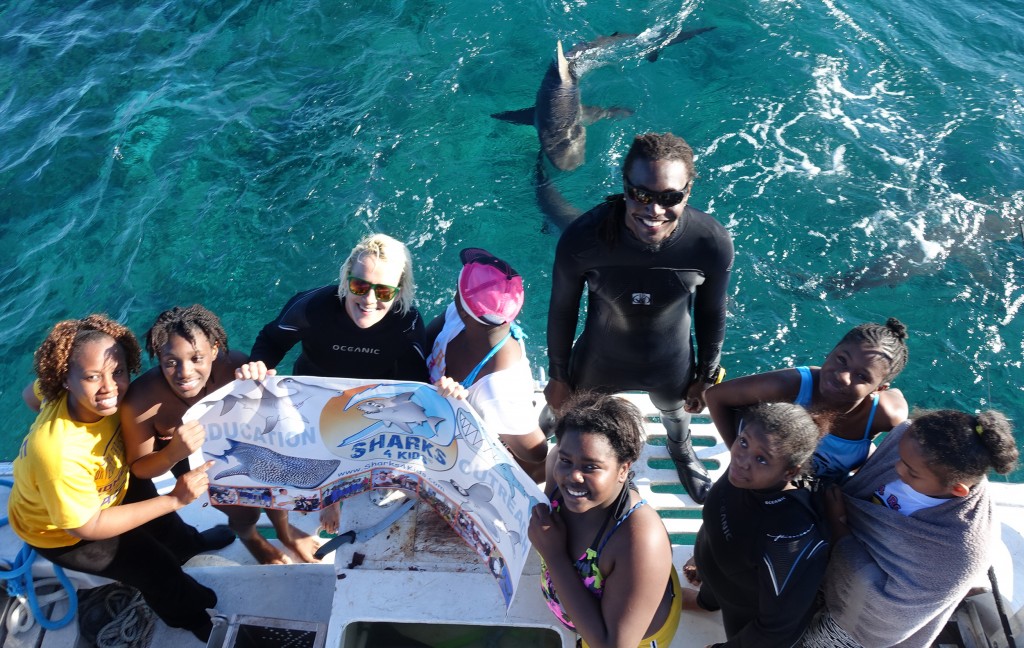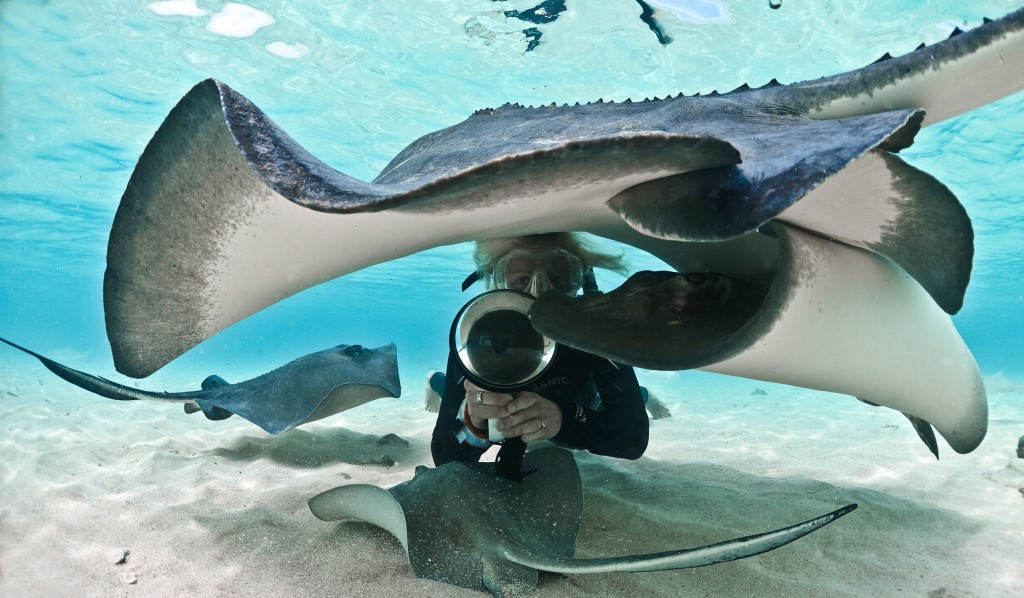Marine Life & Conservation Blogs
Sharks4Kids

 On a recent trip to Bimini, in the Bahamas, we had the chance to meet Jillian and Duncan. They are talented underwater photographers and videographers with a particular passion for sharks. We met on a dive boat, heading out to dive with Great Hammerhead sharks, and chatted about their charity, Sharks4Kids, about shark conservation and our joint passion for shark imagery. We asked Jillian to tell us a little more about what she does.
On a recent trip to Bimini, in the Bahamas, we had the chance to meet Jillian and Duncan. They are talented underwater photographers and videographers with a particular passion for sharks. We met on a dive boat, heading out to dive with Great Hammerhead sharks, and chatted about their charity, Sharks4Kids, about shark conservation and our joint passion for shark imagery. We asked Jillian to tell us a little more about what she does.
Tell us about Sharks4Kids. What does it do now and what you hope to be able to achieve in the future?
Sharks4Kids is a US based non-profit with the goal of creating the next generation of shark advocates through education, outreach and adventure. Founded by a team of marine biologists, videographers and photographers, Sharks4Kids is able to combine science and conservation media to create a unique and dynamic range of shark education materials. The website offers curriculum, videos, activities and more. Skype classroom lessons and Google hangouts also offer teachers and students the opportunity to have an interactive experience with shark scientists and conservationists. Using Skype, the team has connected with over 40,000 students in 37 countries and 47 US States. Our shark education tours have been hosted in Canada, The Bahamas, The United States and the Dutch Caribbean. In person visits have taken our team to 7 different countries and our ambassador program is building. Shark snorkels, dives and tagging trips are also offered as a way of immersing students into the world of sharks and shark science. We will be publishing our first children’s book in April and will have our first app available later in the year.
Sharks4Kids hopes to expand and increase field opportunities, develop more interactive video content and continue to build the next generation of shark advocates around the world.
Tell us a little about yourself, why you love sharks, and how you got involved in shark conservation.
I grew up crawling through tide pools on the Maine coast and swimming in the cold ocean water until my lips turned blue, much to my parents’ dismay. By the time I was 8 years old, I had seen dolphins, manatees and sharks in the wild and my attachment to the ocean became even deeper. I knew from that young age, the ocean was my place and would be a large part of my life. This passion and fascination has only intensified as I’ve gotten older and much of my adult life has revolved around the ocean.
After graduating with a degree in animal behavior I began traveling the world to study sharks, which took me to Florida, The Bahamas, California and Australia. During my travels my love of sharks and want to help conserve them only grew. I realized how much fear and even hatred was associated with these animals and my own experiences were polar opposites of that. I knew I wanted to share their story and help people understand their reality versus the stereotypes and so began a journey to spread shark education and awareness.
I created Sharks4Kids, Inc. in 2012 because I believe kids offer hope for our oceans and for our planet. Their voice can be heard. When given tools, the opportunities for students around the world to make a difference, is endless. They have beautiful visions, stories to tell and creative, unbiased minds to drive action. No matter how young or old, never underestimate your ability to influence, inspire and empower.
I have traveled the world filming and photographing marine life, especially sharks. Perceptions and attitudes are changing, directly propelled by someone’s glimpse into the life of these misunderstood predators. Education and awareness develop understanding and compassion, all of which can be catalyzed by one simple image.
Why are great underwater images and video important to the great work that you do at Sharks4Kids?
It is probably cliché to say, but a picture is really worth a 1000 words and can tell a very powerful story. Showing people the beauty and grace of these animals can replace fear with fascination. Images can also catalyze a curiosity for someone to have their own experience. They allow us to show diversity, adaptations, behaviors, habitats and threats facing sharks. They can also help us learn a tremendous amount about a particular shark or a species. We can also show people in the water with sharks, which is also a powerful tool. Sharks are wild animals and they must be respected, but they are not the man-eating monsters they are so frequently portrayed as. Photos and videos are an invaluable tool for teaching kids around the world about sharks, why they are important and how they can help save these incredible animals.
For more information, visit www.sharks4kids.com.
Marine Life & Conservation Blogs
Creature Feature: Dusky Shark

 In this series, the Shark Trust will be sharing amazing facts about different species of sharks and what you can do to help protect them.
In this series, the Shark Trust will be sharing amazing facts about different species of sharks and what you can do to help protect them.
This month we’re taking a look at the Dusky Shark, a highly migratory species with a particularly slow growth rate and late age at maturity.
Dusky sharks are one of the largest species within the Carcharhinus genus, generally measuring 3 metres total length but able to reach up to 4.2 metres. They are grey to grey-brown on their dorsal side and their fins usually have dusky margins, with the darkest tips on the caudal fin.
Dusky Sharks can often be confused with other species of the Carcharhinus genus, particularly the Galapagos Shark (Carcharhinus galapagensis). They have very similar external morphology, so it can be easier to ID to species level by taking location into account as the two species occupy very different ecological niches – Galapagos Sharks prefer offshore seamounts and islets, whilst duskies prefer continental margins.
Hybridisation:
A 2019 study found that Dusky Sharks are hybridising with Galapagos Sharks on the Eastern Tropical Pacific (Pazmiño et al., 2019). Hybridisation is when an animal breeds with an individual of another species to produce offspring (a hybrid). Hybrids are often infertile, but this study found that the hybrids were able to produce second generation hybrids!
Long distance swimmers:
Dusky sharks are highly mobile species, undertaking long migrations to stay in warm waters throughout the winter. In the Northern Hemisphere, they head towards the poles in the summer and return southwards towards the equator in winter. The longest distance recorded was 2000 nautical miles!
Very slow to mature and reproduce:
The Dusky Shark are both targeted and caught as bycatch globally. We already know that elasmobranchs are inherently slow reproducers which means that they are heavily impacted by overfishing; it takes them so long to recover that they cannot keep up with the rate at which they are being fished. Dusky Sharks are particularly slow to reproduce – females are only ready to start breeding at roughly 20 years old, their gestation periods can last up to 22 months, and they only give birth every two to three years. This makes duskies one of the most vulnerable of all shark species.
The Dusky Shark is now listed on Appendix II of the Convention on the Conservation of Migratory Species (CMS), but further action is required to protect this important species.
Scientific Name: Carcharhinus obscurus
Family: Carcharhinidae
Maximum Size: 420cm (Total Length)
Diet: Bony fishes, cephalopods, can also eat crustaceans, and small sharks, skates and rays
Distribution: Patchy distribution in tropical and warm temperate seas; Atlantic, Indo-Pacific and Mediterranean.
Habitat: Ranges from inshore waters out to the edge of the continental shelf.
Conservation status: Endangered.
For more great shark information and conservation visit the Shark Trust Website
Images: Andy Murch
Diana A. Pazmiño, Lynne van Herderden, Colin A. Simpfendorfer, Claudia Junge, Stephen C. Donnellan, E. Mauricio Hoyos-Padilla, Clinton A.J. Duffy, Charlie Huveneers, Bronwyn M. Gillanders, Paul A. Butcher, Gregory E. Maes. (2019). Introgressive hybridisation between two widespread sharks in the east Pacific region, Molecular Phylogenetics and Evolution 136(119-127), https://doi.org/10.1016/j.ympev.2019.04.013.
Marine Life & Conservation Blogs
Creature Feature: Undulate Ray

 In this series, the Shark Trust will be sharing amazing facts about different species of sharks and what you can do to help protect them.
In this series, the Shark Trust will be sharing amazing facts about different species of sharks and what you can do to help protect them.
This month we’re looking at the Undulate Ray. Easily identified by its beautiful, ornate pattern, the Undulate Ray gets its name from the undulating patterns of lines and spots on its dorsal side.
This skate is usually found on sandy or muddy sea floors, down to about 200 m deep, although it is more commonly found shallower. They can grow up to 90 cm total length. Depending on the size of the individual, their diet can range from shrimps to crabs.
Although sometimes called the Undulate Ray, this is actually a species of skate, meaning that, as all true skates do, they lay eggs. The eggs are contained in keratin eggcases – the same material that our hair and nails are made up of! These eggcases are also commonly called mermaid’s purses and can be found washed up on beaches all around the UK. If you find one, be sure to take a picture and upload your find to the Great Eggcase Hunt – the Shark Trust’s flagship citizen science project.
It is worth noting that on the south coasts, these eggcases can be confused with those of the Spotted Ray, especially as they look very similar and the ranges overlap, so we sometimes informally refer to them as ‘Spundulates’.
Scientific Name: Raja undulata
Family: Rajidae
Maximum Size: 90cm (total length)
Diet: shrimps and crabs
Distribution: found around the eastern Atlantic and in the Mediterranean Sea.
Habitat: shelf waters down to 200m deep.
Conservation Status : As a commercially exploited species, the Undulate Ray is a recovering species in some areas. The good thing is that they have some of the most comprehensive management measures of almost any elasmobranch species, with both minimum and maximum landing sizes as well as a closed season. Additionally, targeting is entirely prohibited in some areas. They are also often caught as bycatch in various fisheries – in some areas they can be landed whilst in others they must be discarded.
IUCN Red List Status: Endangered
For more great shark information and conservation visit the Shark Trust Website
Image Credits: Banner – Sheila Openshaw; Illustration – Marc Dando
-

 News3 months ago
News3 months agoHone your underwater photography skills with Alphamarine Photography at Red Sea Diving Safari in March
-

 News3 months ago
News3 months agoCapturing Critters in Lembeh Underwater Photography Workshop 2024: Event Roundup
-

 Marine Life & Conservation Blogs3 months ago
Marine Life & Conservation Blogs3 months agoCreature Feature: Swell Sharks
-

 Blogs2 months ago
Blogs2 months agoMurex Resorts: Passport to Paradise!
-

 Blogs2 months ago
Blogs2 months agoDiver Discovering Whale Skeletons Beneath Ice Judged World’s Best Underwater Photograph
-

 Gear Reviews2 weeks ago
Gear Reviews2 weeks agoGEAR REVIEW – Revolutionising Diving Comfort: The Sharkskin T2 Chillproof Suit
-

 Gear Reviews3 months ago
Gear Reviews3 months agoGear Review: Oceanic+ Dive Housing for iPhone
-

 Marine Life & Conservation2 months ago
Marine Life & Conservation2 months agoSave the Manatee Club launches brand new webcams at Silver Springs State Park, Florida
























